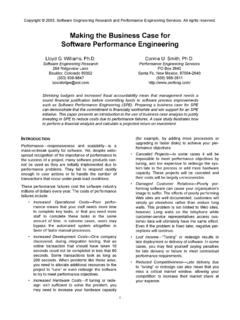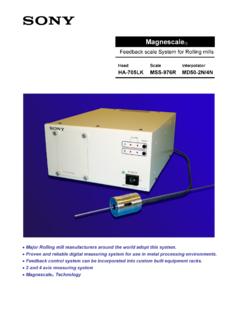Transcription of SOFTWARE PERFORMANCE ENGINEERING
1 1 Chapter 16 SOFTWARE PERFORMANCE ENGINEERING Connie U. Smith1 and Lloyd G. Williams2 1 PERFORMANCE ENGINEERING Services, PO Box 2640, Santa Fe, NM 87504, 2 SOFTWARE ENGINEERING Research, 264 Ridgeview Lane, Boulder, CO 80302, (303) 938-9847 Abstract: PERFORMANCE is critical to the success of today s SOFTWARE systems. However, many SOFTWARE products fail to meet their PERFORMANCE objectives when they are initially constructed. Fixing these problems is costly and causes schedule delays, cost overruns, lost productivity, damaged customer relations, missed market windows, lost revenues, and a host of other difficulties. This chapter presents SOFTWARE PERFORMANCE ENGINEERING (SPE), a systematic, quantitative approach to constructing SOFTWARE systems that meet performanced objectives.
2 SPE begins early in the SOFTWARE development process to model the per-formance of the proposed architecture and high-level design. The models help to identify potential PERFORMANCE problems when they can be fixed quickly and economically. Key words: PERFORMANCE , SOFTWARE PERFORMANCE ENGINEERING , architecture 1. INTRODUCTION While the functionality delivered by a SOFTWARE application is obviously important, it is not the only concern. Over its lifetime, the cost of a SOFTWARE product is determined more by how well it achieves its objectives for quality attributes such as PERFORMANCE , reliability/availability or maintainability than by its functionality. This chapter focuses on developing SOFTWARE systems that meet PERFORMANCE objectives. PERFORMANCE is the degree to which a SOFTWARE system or component meets its objectives for timeliness.
3 Thus, PERFORMANCE is any characteristic of a SOFTWARE product that you could, in principle, measure by sitting at the computer with a stopwatch in your hand. 2 Chapter 16 There are two important dimensions to SOFTWARE PERFORMANCE : responsiveness and scalability. Responsiveness is the ability of a system to meet its objectives for response time or throughput. In real-time systems, responsiveness is a measure of how fast the system responds to an event, or the number of events that can be processed in a given time. Scalability is the ability of a system to continue to meet its response time or throughput objectives as the demand for the SOFTWARE functions increases. Scalability is an increasingly important aspect of today s SOFTWARE systems. PERFORMANCE is critical to the success of today s SOFTWARE systems.
4 However, many SOFTWARE products fail to meet their PERFORMANCE objectives when they are initially constructed. Fixing these problems is costly and causes schedule delays, cost overruns, lost productivity, damaged customer relations, missed market windows, lost revenues, and a host of other difficulties. In extreme cases, it may not be possible to fix PERFORMANCE problems without extensive redesign and re-implementation. In those cases, the project either becomes an infinite sink for time and money, or it is, mercifully, canceled. PERFORMANCE cannot be retrofitted; it must be designed into SOFTWARE from the beginning. The make it run, make it run right, make it run fast approach is dangerous. Recent interest in SOFTWARE architectures has underscored the importance of architecture in achieving SOFTWARE quality objectives, including PERFORMANCE .
5 While decisions made at every phase of the development process are important, architectural decisions have the greatest impact on quality attributes such as modifiability, reusability, reliability, and PERFORMANCE . As Clements and Northrup note [Clements and Northrup 1996]: Whether or not a system will be able to exhibit its desired (or required) quality attributes is largely determined by the time the architecture is chosen. Our experience is that PERFORMANCE problems are most often due to inappropriate architectural choices rather than inefficient coding. By the time the architecture is fixed, it may be too late to achieve adequate PERFORMANCE by tuning. While a good architecture cannot guarantee attainment of PERFORMANCE objectives, a poor architecture can prevent their achievement.
6 This chapter presents an overview of SOFTWARE PERFORMANCE ENGINEERING (SPE), a systematic, quantitative approach to constructing SOFTWARE systems that meet performanced objectives. SPE prescribes principles for creating responsive SOFTWARE , the data required for evaluation, procedures for obtaining PERFORMANCE specifications, and guidelines for the types of evaluation to be conducted at each development stage. It incorporates models for representing and predicting PERFORMANCE as well as a set of analysis methods [Smith 1990]. Use of the UML for deriving SPE models is discussed in [Smith and Williams 2002]. 16. SOFTWARE PERFORMANCE ENGINEERING 3 Because of the importance of architecture in determining PERFORMANCE , SPE takes an architectural perspective.
7 The principles and techniques of SPE form the basis for PASASM, a method for PERFORMANCE assessment of SOFTWARE architectures [Williams and Smith 2002]. PASA was developed from experience in conducting PERFORMANCE assessments of multiple SOFTWARE architectures in several application domains including web-based systems, financial applications, and real-time systems. It uses the principles and techniques described in this chapter to determine whether an architecture is capable of supporting its PERFORMANCE objectives. When a problem is found, PASA also identifies strategies for reducing or eliminating those risks. The PASA process consists of ten steps [Williams and Smith 2002]. They are based on the SPE modeling process described below.
8 The method may be applied to new development to uncover potential problems when they are easier and less expensive to fix. It may also be used when upgrading legacy systems to decide whether to continue to commit resources to the current architecture or migrate to a new one. And it may be used on existing systems with poor PERFORMANCE that require speedy correction. The next section describes the SPE model-based approach. The SPE modeling process is then illustrated with a case study. 2. OVERVIEW OF SOFTWARE PERFORMANCE ENGINEERING SPE is a model-based approach that uses deliberately simple models of SOFTWARE processing with the goal of using the simplest possible model that identifies problems with the system architecture, design, or implementation plans. These models are easily constructed and solved to provide feedback on whether the proposed SOFTWARE is likely to meet PERFORMANCE goals.
9 As the SOFTWARE process proceeds, the models are refined to more closely represent the PERFORMANCE of the emerging SOFTWARE . The precision of the model results depends on the quality of the estimates of resource requirements. Because these are difficult to estimate for SOFTWARE architectures, SPE uses adaptive strategies, such as upper- and lower-bounds estimates and best- and worst-case analysis to manage uncertainty. For example, when there is high uncertainty about resource requirements, analysts use estimates of the upper and lower bounds of these quantities. Using these estimates, analysts produce predictions of the best-case and SM PASA and PERFORMANCE Assessment of SOFTWARE Architectures Method are service marks of SOFTWARE ENGINEERING Research and PERFORMANCE ENGINEERING Services.
10 4 Chapter 16 worst-case PERFORMANCE . If the predicted best-case PERFORMANCE is unsatisfactory, they seek feasible alternatives. If the worst-case prediction is satisfactory, they proceed to the next step of the development process. If the results are somewhere in between, analyses identify critical components whose resource estimates have the greatest effect and focus on obtaining more precise data for them. A variety of techniques can provide more precision, including: further refining the architecture and constructing more detailed models or constructing PERFORMANCE prototypes and measuring resource requirements for key components. Two types of models provide information for architecture assessment: the SOFTWARE execution model and the system execution model.









